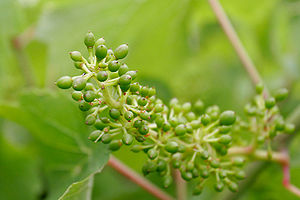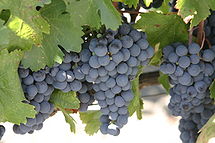
Coulure
Encyclopedia

Grape
A grape is a non-climacteric fruit, specifically a berry, that grows on the perennial and deciduous woody vines of the genus Vitis. Grapes can be eaten raw or they can be used for making jam, juice, jelly, vinegar, wine, grape seed extracts, raisins, molasses and grape seed oil. Grapes are also...
s to develop after flowering. In English the word shatter is sometimes used. Coulure is triggered by periods of cold, cloudy, rainy weather or very high out-of-season temperatures. The condition is most often manifested in the spring
Spring (season)
Spring is one of the four temperate seasons, the transition period between winter and summer. Spring and "springtime" refer to the season, and broadly to ideas of rebirth, renewal and regrowth. The specific definition of the exact timing of "spring" varies according to local climate, cultures and...
. It also occurs in vines that have little sugar content in their tissue
Vascular tissue
Vascular tissue is a complex conducting tissue, formed of more than one cell type, found in vascular plants. The primary components of vascular tissue are the xylem and phloem. These two tissues transport fluid and nutrients internally. There are also two meristems associated with vascular tissue:...
. Flowers stay closed and are not fertilized
Biological dispersal
Biological dispersal refers to species movement away from an existing population or away from the parent organism. Through simply moving from one habitat patch to another, the dispersal of an individual has consequences not only for individual fitness, but also for population dynamics, population...
. Thus the vines are not pollinated as the grape fails to develop and falls off. Coulure can also cause irregular bunches of grapes which are less compact than normal. These bunches are more sensitive to developing various grape diseases. The yield
Yield (wine)
In viticulture, the yield is a measure of the amount of grapes or wine that is produced per unit surface of vineyard, and is therefore a type of crop yield...
of a vine with coulure will decrease substantially. Grape varieties with high proclivity to coulure are Grenache
Grenache
Grenache is one of the most widely planted red wine grape varieties in the world. It ripens late, so it needs hot, dry conditions such as those found in Spain, the south of France, and California's San Joaquin Valley. It is generally spicy, berry-flavored and soft on the palate with a relatively...
, Malbec
Malbec
Malbec is a purple grape variety used in making red wine. The grapes tend to have an inky dark color and robust tannins, and are long known as one of the six grapes allowed in the blend of red Bordeaux wine. The French plantations of Malbec are now found primarily in Cahors in the South West...
, Merlot
Merlot
Merlot is a darkly blue-coloured wine grape, that is used as both a blending grape and for varietal wines. The name Merlot is thought to derive from the Old French word for young blackbird, merlot, a diminutive of merle, the blackbird , probably from the color of the grape. Merlot-based wines...
, and Muscat Ottonel
Muscat Ottonel
Muscat Ottonel or Muskat-Ottonel is a white wine grape that is a member of the Muscat family of Vitis vinifera. It is most notable for its use in dessert wines from Austria, Croatia and Serbia as well as dry wines from Alsace and Hungary...
. Other causes of coulure may be vineyard conditions and practices, pruning
Pruning
Pruning is a horticultural practice involving the selective removal of parts of a plant, such as branches, buds, or roots. Reasons to prune plants include deadwood removal, shaping , improving or maintaining health, reducing risk from falling branches, preparing nursery specimens for...
too early or too severely, excessively fertile soils or overuse of fertilizers, and improper selection of rootstocks or clones.
Cause and effect

Carbohydrate
A carbohydrate is an organic compound with the empirical formula ; that is, consists only of carbon, hydrogen, and oxygen, with a hydrogen:oxygen atom ratio of 2:1 . However, there are exceptions to this. One common example would be deoxyribose, a component of DNA, which has the empirical...
deficiency in the plant tissues that causes the vine to conserve resources that would otherwise be funneled into the developing grape berries. As carbohydrate levels drop, soon after flowering the stems connected to the berries shrivel as the small grapes (0.2 inches/5 millimeters in diameter) eventually fall off. To some extent coulure and the dropping of fruit is a natural and healthy reaction of a vine that is self regulating its resource and the amount of fruit that it produces. But when the situation is exacerbated by certain weather conditions and disruption to photosynthesis
Photosynthesis
Photosynthesis is a chemical process that converts carbon dioxide into organic compounds, especially sugars, using the energy from sunlight. Photosynthesis occurs in plants, algae, and many species of bacteria, but not in archaea. Photosynthetic organisms are called photoautotrophs, since they can...
, coulure can have a more severe impact on yields that may negatively affect a region's grape supply and thus influence pricing.
When the weather is the primary instigator of coulure, the French term this phenomenon coulure climatique. This describes the cloudy and wet conditions that limit the amount of photosynthetic activity that takes place during the flowering cycle of a grapevine. Limited sunshine means lower sugar levels that can be converted into resources to develop grape berries. Warm temperatures can also exacerbate coulure in some grape varieties by promoting cellular respiration
Cellular respiration
Cellular respiration is the set of the metabolic reactions and processes that take place in the cells of organisms to convert biochemical energy from nutrients into adenosine triphosphate , and then release waste products. The reactions involved in respiration are catabolic reactions that involve...
and excessive shoot
Shoot
Shoots are new plant growth, they can include stems, flowering stems with flower buds, and leaves. The new growth from seed germination that grows upward is a shoot where leaves will develop...
growth that further competes with the berries for the resources derived from carbohydrates. Other contributing include excessively fertile vineyard soils, either naturally or enhanced by the use of nitrogen
Nitrogen
Nitrogen is a chemical element that has the symbol N, atomic number of 7 and atomic mass 14.00674 u. Elemental nitrogen is a colorless, odorless, tasteless, and mostly inert diatomic gas at standard conditions, constituting 78.08% by volume of Earth's atmosphere...
-rich fertilizers, overly vigorous rootstock and severe pruning that too drastically limits the amount of leaf surface needed to sustain photosynthesis.
Prevention

Grenache
Grenache is one of the most widely planted red wine grape varieties in the world. It ripens late, so it needs hot, dry conditions such as those found in Spain, the south of France, and California's San Joaquin Valley. It is generally spicy, berry-flavored and soft on the palate with a relatively...
, Malbec
Malbec
Malbec is a purple grape variety used in making red wine. The grapes tend to have an inky dark color and robust tannins, and are long known as one of the six grapes allowed in the blend of red Bordeaux wine. The French plantations of Malbec are now found primarily in Cahors in the South West...
, Merlot
Merlot
Merlot is a darkly blue-coloured wine grape, that is used as both a blending grape and for varietal wines. The name Merlot is thought to derive from the Old French word for young blackbird, merlot, a diminutive of merle, the blackbird , probably from the color of the grape. Merlot-based wines...
and Muscat Ottonel
Muscat Ottonel
Muscat Ottonel or Muskat-Ottonel is a white wine grape that is a member of the Muscat family of Vitis vinifera. It is most notable for its use in dessert wines from Austria, Croatia and Serbia as well as dry wines from Alsace and Hungary...
. A grower can choose to grow clones of those varieties, now commonly available for Merlot and Malbec, that have less susceptibility to developing coulure. In the vineyard, care can be taken to not prune so severely and insure that there is adequate leaf coverage for photosynthesis. Trimming the tips of developing shoots near the end of the flowering period can lessen the competition for sugar resources between berries and new shoot development. For non-organic viticulture, chemical growth inhibitors can be applied to the vine to limit shoot growth as well.

